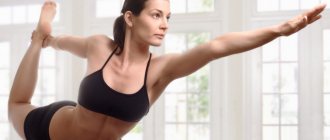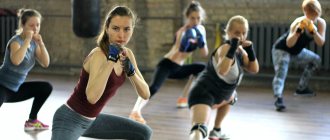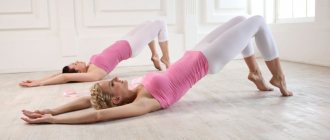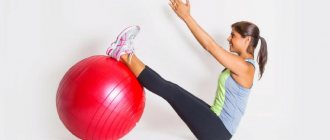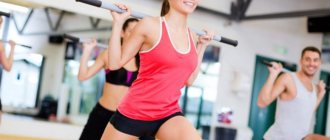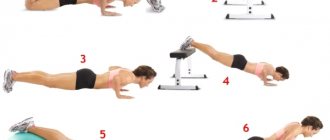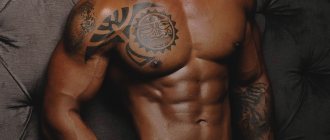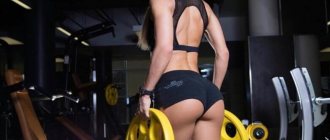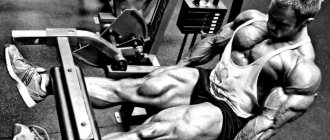Probably every girl in childhood at least once imagined herself in the role of a ballerina, light, beautiful and graceful. Now this childhood dream can come true - thanks to a new dance direction called “Body Ballet”.
This type of training involves less workload than in professional ballet. But even when doing the lighter version, dancers get beautiful posture, a strong muscle frame, excellent flexibility and good health. All exercises are suitable for those who have not undergone professional ballet training.
Beautiful slow music, a hall of mirrors, graceful movements of the hands and the whole body... This is exactly what every woman needs to at least sometimes feel like a fairy-tale princess.
What is Body Ballet and what is it eaten with?
Body ballet is a modernized, lighter version of ballet, including lessons based on stretching, choreography, yoga and aerobics. Unlike classical dance, this type of fitness does not require special preparation; you can start classes at different ages; there are no restrictions on gender or weight. The complex is based on ballet dance movements, which can be performed with or without the use of a choreographic machine, mirror.
It is necessary to distinguish between body ballet - this is a type of fitness, and ballet itself, which is a full-fledged choreography. The basis of Body Ballet is the main movements of ballerinas, adapted for performance in a fitness program. The emphasis is on the essence of the exercises, the quality of their execution, and not just on technique. The so-called barre complex (translated from English as “ballet barre”) helps not only stretch the muscles, but also strengthen them. The result is flexibility throughout the body, good posture and minus a few kilograms!
And body ballet appeared in fitness thanks to choreographer and sports trainer Leah Sarago (USA). In 2005, the fitness expert developed a course where she for the first time combined ballet steps with elements from Pilates and yoga. This idea for gaining a toned body was supported by the Russian ballerina Ilze Liepa, creating a mix of exemplary ballet and Pilates. There are fitness body ballet, based on a sports program, and dance body ballet. The goal of both directions is to improve physical condition and psychological well-being. Lessons are conducted under relaxing, pleasant music, which allows you to relieve stress, nervous tension and lift your spirits.
Clear benefits and possible results from body ballet
Body ballet has a moderate tempo without jerky movements, which minimizes the level of injury. Thanks to body ballet, after a month of training, visible results appear:
- Muscle tension is eliminated;
- Pain in the lower back, back disappears;
- Tendons are stretched, joints are developed;
- Incorrect posture is corrected;
- Excess fat is eliminated;
- Coordination of movements improves;
- Grace and plasticity develop.
Body ballet classes ensure the drawing of graceful body contours, rather than building muscle mass. Combining ballet steps and stretching lessons makes your legs toned, eliminating the appearance of “breeches”, heavily pumped hips and calves, as after strength training. A stretched toe ensures stretching of the muscle fibers along, which eliminates the effect of swaying legs. At the same time, a correct, beautiful arch of the foot is formed, and flat feet are prevented. The presence of Pilates elements strengthens the muscles of the abs, shoulders and arms. Body ballet is useful for the normal functioning of the musculoskeletal system, preventing the development of osteochondrosis, scoliosis, and arthritis. Ballet fitness choreography will teach you to control and love your body!
Benefits of practicing ballet at home
Choreography is one of the highest types of dance activity. Ballet movements were created by the best French and Russian choreographers for performance on stage.
With the help of ballet classes, you can learn to feel your body, understand music and move with it to the same rhythm. By regularly practicing ballet, you will improve coordination of movements and train the vestibular apparatus. In addition, ballet classes correct your figure, help you get rid of extra pounds, correct your posture, and sometimes you may experience an increase in the length of your legs and neck, which always looks very elegant.
A passion for ballet is a great way to become interesting to yourself, your beloved man and those around you. For some people, life follows the principle of “work-home”, “home-work”, no hobbies, everything is gray and mundane. Bring new colors and emotions into your life! When a person does what he likes, his eyes light up, and in other areas of life everything begins to improve. The groom or husband will definitely appreciate your efforts, slender figure and acquired grace.
Indications and contraindications for body ballet
Body ballet fitness training has no age restrictions and is aimed at people of any gender and size. Classes are held in a mode that is gentle on joints and ligaments, therefore they are recommended for everyone for whom shock loads are contraindicated. Most exercises are suitable for beginners with zero level of training. Ballet positions are especially useful for people who spend many hours at the computer or lead an inactive lifestyle. You won't become a professional ballerina, but you will have a chance to do the splits!
Body ballet is an opportunity for people who were not into dancing and avoided sports activities to develop all muscle groups. Be prepared to feel like a squeezed lemon at first. But after 4-5 weeks the body will get used to it, and pleasant flexibility will become an inseparable part of life.
But there are standard medical contraindications to physical activity. You cannot practice body-ballet if you have problems with the cardiovascular system, severe stage of varicose veins, elevated temperature, or exacerbation of chronic diseases. Training is contraindicated for pregnant women and women in the first months after childbirth. Doctors recommend body ballet to athletes and dancers during the rehabilitation period after injuries to strengthen muscles and work out joints.
Exercise technique: from warm-up to cool-down!
The standard training algorithm includes the following points:
- Warm-up, gymnastics;
- Lessons at the barre/chair;
- Exercises without support in a standing position;
- Pilates elements on the floor;
- Stretching, stretching.
An obligatory part of body ballet classes is a warm-up, which is necessary to warm up the muscular system and prepare it for the load. The training program includes the basic elements of classical ballet dance (plie, pirouettes, batmans), power movements, and entire choreographic sketches. At the end of the lesson, you need to stretch, let your muscles cool down, and do a cool-down. The complexity and pace of exercises should be increased gradually. Beginners work with their own body weight; later, sports equipment is added to the training: dumbbells, fitness tape, balls.
Despite the fact that ballet choreography is adapted for sports and fitness, it is important to follow the technique of its execution. This will help achieve the best results and minimize the likelihood of injury. At the beginning, it is better to train with an instructor, watch yourself in the mirror to hone your technique. The duration of the lesson in moderate intensity mode is 40-60 minutes.
Question to ask: will body ballet help you lose weight?
Attending body ballet classes is recommended for people who want to lose a couple of kilograms of excess weight. During training, the heart rate reaches more than 130 beats, allowing the body to burn calories. In combination with a healthy diet, the result in the form of a more toned body will be noticeable in 1-2 months. But the main goal of this fitness program is still considered to be the development of flexibility, the formation of healthy posture, muscle stretching, and for the purpose of losing weight, body ballet is prescribed as an auxiliary load.
How to practice ballet at home?
- The structure of choreography classes is very standard and it doesn’t matter whether you study with a trainer or at home.
- First come the easiest exercises to warm up and stretch the muscles. Then long and complex exercises are performed. A few hours before classes you need to eat well, otherwise you may simply not have enough strength and energy.
- You definitely need a machine, since all the basic exercises are performed on it. At the end you need to do some stretching. It is not done on a machine, but in free space - jumps, spins and the obligatory final bow are practiced.
- You should practice ballet 2-3 times a week for an hour, or you can do it for an hour and a half. If you do this regularly, you will notice results within a month. Your shoulders will straighten, your posture will become more proud, and your self-confidence will increase.
- There is an opinion that to practice ballet you need to buy a special uniform, including pointe shoes and a tutu. It's a delusion. To dance fluently on pointe shoes requires years of training, and a beginner simply cannot stand on them. For beginners, it's best to use a regular workout uniform, such as leggings, or stretchy, tight pants or a top. Special ballet slippers, which can be found in stores for dancers, are suitable as shoes. You should buy such shoes in a slightly smaller size than you wear in everyday life, since ballet slippers should fit snugly to your feet.
Examples of exercises: feel like Plisetskaya!
The regular training program depends on the choice of fitness trainer, the level of training of the group, etc. But most often, after warming up the muscles, a cycle of exercises is performed on a choreographic machine (replaced with a chair at home) and without it. Even at home, you can feel like a professional ballerina if you do:
- Grand plié. These are deep squats, with the legs in the second position. The back is straight. The position of the arms is bent at the elbows in front of the body. During a squat, your arms need to be raised up.
- Grand Batman back. The back is straight. Position with your back to the chair/machine. Holding it with your hand, take your leg back and rest your outstretched toe on the floor. Make a sharp swing with your straight leg as high as possible.
- Releve. Holding the handrail with your hand from the second position, you lift your body onto half-toes.
- Body tilts. The straight leg is thrown onto the handrail, the arm on the same side is raised up. While tilting your body, you should try to reach with your hand the toe of your foot located on the machine/back of the chair.
- Leg in pass. The legs are in fifth position. One hand lies on the machine, the other is slightly bent and raised up. One leg bends, its foot rises to the knee and returns to its original position.
- Jumping from first position. The back is straight. Hands on waist. Bounce in place for 30-50 seconds, straightening your toes.
For body ballet classes, you don’t need to buy fluffy tutu skirts. Sportswear for fitness that does not restrict movement is suitable. Overalls, bodysuits, tights and leggings or shorts with tops, T-shirts and T-shirts, and leggings will allow you to feel free. It is advisable to train in comfortable clothes for Pilates or aerobics. It is also not necessary to wear pointe shoes. Give preference to Czech shoes, sports ballet shoes, special dance shoes or even socks. Many girls use the same sets of clothes and accessories when moving from one training room to another. The main thing is that you feel comfortable doing the exercises, and that the trainer monitors the cleanliness of their execution. After a Body Ballet workout, you will want to straighten your shoulders and breathe deeply!
Necessary conditions and attributes for studying at home
It’s worth starting with the fact that it is necessary to study professional ballet in special educational institutions.
If it seems that the question of how to become a ballerina at home implies subsequent professional training, and then getting a real job in the theater, then you will be a little disappointed. Why? However, this does not mean at all that those who have not attended special training since childhood can say goodbye to the dream of ballet forever. After all, the main thing is not only ballet shoes, but also skills and abilities that you can learn on your own. You can dance for your own pleasure, practice in non-professional groups, and even record and post videos of your own performances for public viewing!
Having dealt with the question of how to become a ballerina at home, you can move on to the next question - what is required for this.
- Firstly, it is the availability of free time. One training session will take at least 1 hour.
- Secondly, these are comfortable clothes. It is not necessary to run for a tutu; it is enough to have a comfortable tracksuit or any other clothing that does not restrict movement.
- Thirdly, these are shoes. Ballet shoes are for those who know how to use them. For beginners, ordinary Czech shoes or light sports shoes are suitable. You can switch to pointe shoes after special training.

